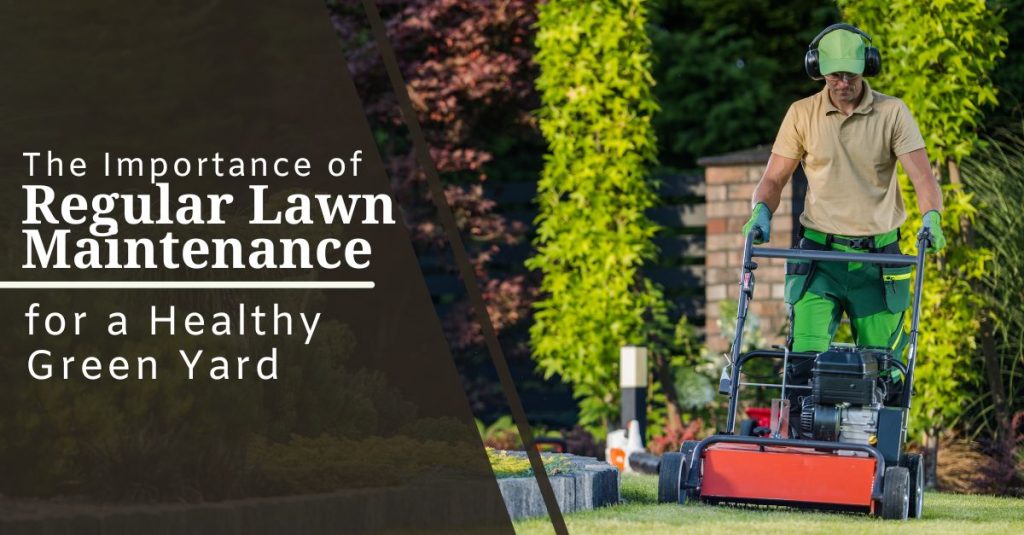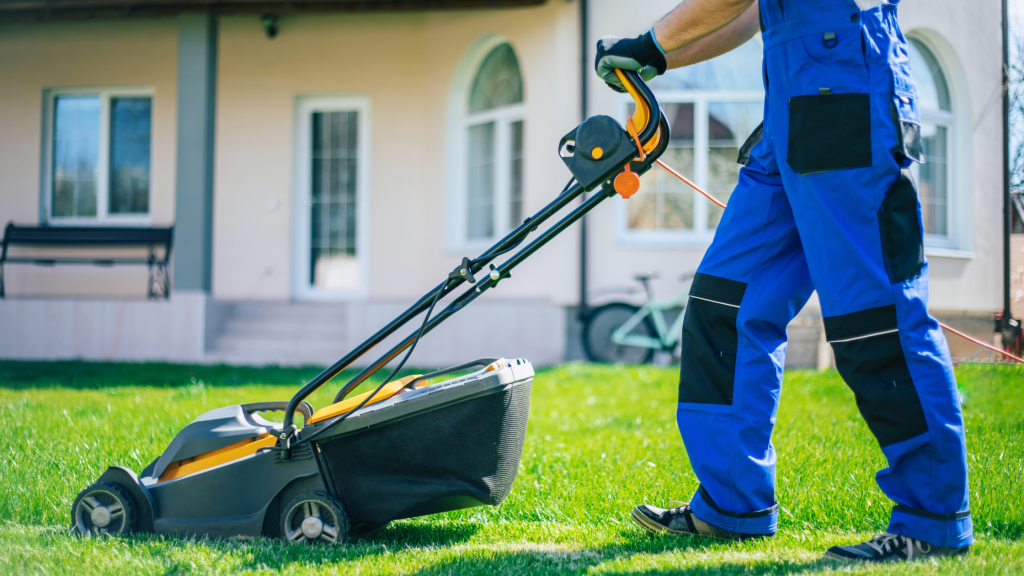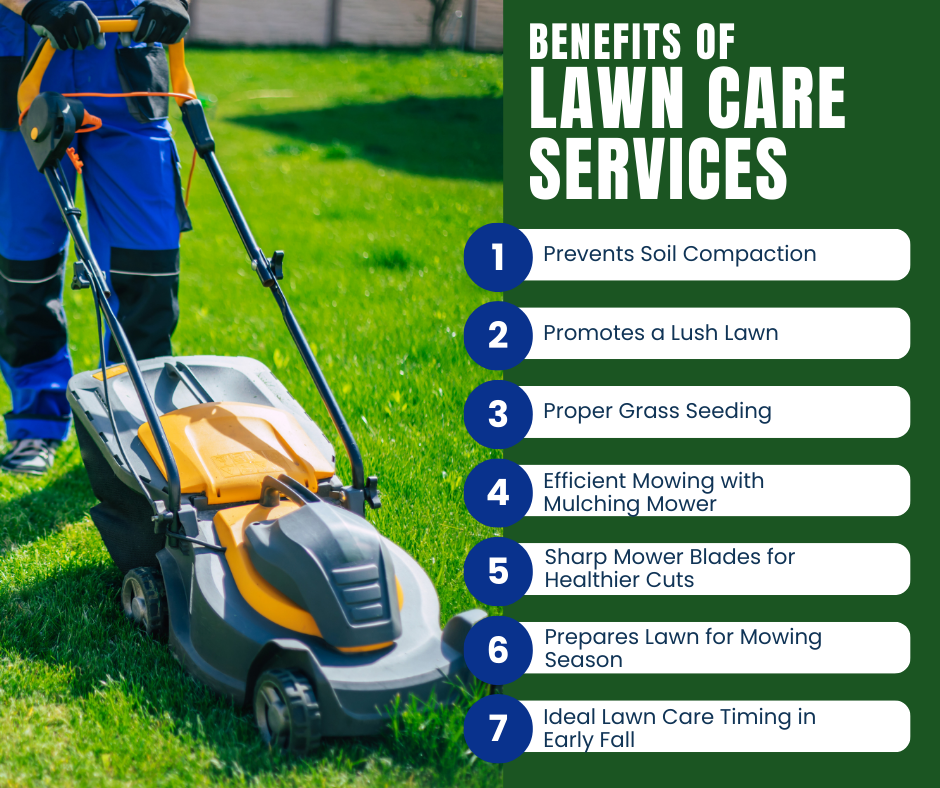
A beautiful green lawn is everyone’s pride, but sure enough, it won’t mow itself. Regular lawn maintenance will keep your yard healthy, vibrant, and full of life.
Whether you have fun cutting around the lawn or just want a beautiful yard, the techniques in this guide will help you realize why lawn care is important and how to do it right. Healthy lawns add value to homes as an addition of good environmental values for attractive homes.
That said, let’s get this started!
Why Regular Lawn Maintenance Matters
Besides being healthy for your yard in its entirety, lawn care is aesthetically required. A healthy lawn absorbs rainwater, reduces erosion, and cleans the air.
Studies show that a well-maintained lawn can increase property values by 15% to 20%. This means you’re maintaining a beautiful yard while making a wise investment.
Lawn Maintenance Tips
A healthy lawn needs proper care and attention. Proper advice will guide you in keeping your yard green and nice all year round. Here are some simple lawn maintenance care tips to get you going:

Mowing: The Foundation of a Healthy Lawn
Mowing is the first step in lawn care that makes your grass uniform in growth. This would make your lawn stronger and healthier, as pests and diseases would be far away. The grass is kept at certain heights that will prevent weeds from growing and allow nutrients to reach deeper into the roots.
How often should you mow?
Most lawns need mowing once a week during the growing season, but twice a month would probably suffice during cooler months. According to professionals, your grass should stand between 3 to 3.5 inches tall because this promotes appropriate root growth and will prevent weeds.
When is the best time to water?
It is really important to keep a lawn moist and green. However, too much or too little water can damage your lawn. Typically, it needs 1-2 inches of water, including rainfall, to stay healthy.
When is the best time to water?
Water early, before 10 a.m. so that water has time to infiltrate the soil before it may evaporate quickly off grass blades. Don’t water at night because the chances of fungus growth are high since moisture stays longer on grass blades.
Fertilizing: Feed Your Lawn the Nutrients It Needs
Grass thrives well with the availability of nutrients and good, healthy soil. Fertilization implies that your soil shall have every nutrient to keep your strong grass. Balanced fertilizer containing nitrogen, phosphorus, and potassium will keep roots in excellent condition.
How often should you fertilize?
Experts claim that your lawn needs fertilizer 2 to 4 times a year, depending on grass and type of soil. The best seasons to fertilize are early spring, summer, and fall—most of the grass grows during these seasons.
Weed Control: Keep Unwanted Plants at Bay
Grass often fights weeds for its resources like sunlight, water and nutrients. That’s why they should be kept in control, especially by regular mowing, proper watering and fertilizing.
When to apply weed control?
Applying pre-emergent weed control in early spring prevents crabgrass from rising. Spot treatments on visible weeds keep a lawn weed-free throughout the year.
Aeration: Let Your Lawn Breathe
Over time, soil can become compacted, making it difficult for air, water, and nutrients to reach the grass roots. Aeration enhances the soil structure and promotes better nutrient absorption for thicker grass.
How often should you aerate?
Aeration is typically needed once a year, usually in the summer, fall or late spring, depending on your soil type and how much foot traffic your lawn gets.
Mulching and Grasscycling: Recycle Nutrients
Mulching involves leaving small grass clippings behind on your lawn after mowing, which can act as a natural fertilizer. This process of mulch, known as grasscycling, helps return nutrients to the soil and reduces the need for additional fertilizers.
How much can this save?
By grasscycling, you can reduce the need for store-bought fertilizer by up to 25%, saving both money and time while also contributing to your lawn’s health.
Pest Control: Defending Against Lawn Invaders
A healthy lawn is less susceptible to pests, but sometimes additional pest control is necessary to keep your lawn whole. Grubs, ants, and other insects can damage your yard if left unchecked. Regularly inspecting your lawn and treating for pests when needed will help control weeds and keep your grass strong.
Tip: Applying pest control in late summer when pests and weeds are most active can help prevent an infestation of common pests and keep your lawn thriving.
Benefits of Lawn Care Services
Professional lawn care provides many benefits to keep your lawn looking its best. Lawn care professionals know how to prevent soil compaction, allowing your grass to grow thick and strong.
They use tools like mulching mowers and sharp mower blades to keep your yard green during the mowing season. Services such as applying grass seed and mowing in early fall can really improve your lawn’s health.By trusting the experts, your lawn will stay vibrant and beautiful all year long! Here are some benefits you can get from lawn care professionals:

Prevents Soil Compaction
Lawn care professionals help prevent soil compaction, allowing roots to grow deeper and absorb more nutrients, which leads to a healthier lawn, especially in high-traffic areas. This results in improved water infiltration and less surface runoff, benefiting the overall health of your yard.
Promotes a Lush Lawn
Lawn care professionals ensure your lawn gets the right nutrients and treatments to maintain a thick, green, and lush lawn throughout the year, even during dry seasons. Consistent care helps prevent weed growth and maintains an even texture, enhancing the visual appeal of your yard.
Proper Grass Seeding
Experts know the best times to apply grass seed, filling in bare patches and ensuring even growth, so your lawn looks full and healthy in every corner. They also select the right seed varieties for your climate, which boosts resilience and reduces the need for frequent re-seeding.
Efficient Mowing with Mulching Mower
Using a mulching or mower blade, professionals return clippings to the soil, acting as natural fertilizer while also helping to retain moisture for better growth. This technique also reduces yard waste and lowers the need for chemical fertilizers, contributing to a more eco-friendly lawn care routine.
Sharp Mower Blades for Healthier Cuts
Lawn and turf care services use sharp mower blades to create clean cuts, which heal faster and reduce the risk of disease, keeping your grass strong and vibrant. Sharp blades also ensure an even cut, preventing uneven growth and enhancing the overall appearance of your lawn.
Prepares Lawn for Mowing Season
Lawn care experts prepare your lawn at the start of the mowing season, ensuring the soil, grass, and roots are ready for regular maintenance and growth. This preparation includes addressing any winter damage and adjusting soil nutrients to support a strong start to the growing season.
Ideal Lawn Care Timing in Early Fall
Early fall is the perfect time for many lawn care treatments, giving your grass time to strengthen before winter and ensuring it bounces back healthier in the spring. Applying treatments during this time helps the lawn recover from summer stress and improves its resilience against pests and diseases.
Lawn Care Routine
Keeping your lawn looking great doesn’t have to be hard. By following a few easy steps, you can make sure your grass stays green and healthy all year.
Here’s a simple lawn care routine anyone can follow:
- Stop Weeds Before They Start: Prevent weeds from growing by using a pre-emergent herbicide. This type of product stops weed seeds, like crabgrass, from sprouting. It’s most effective when used in early spring.
- Get Rid of Weeds That Have Sprouted: Big weeds like dandelions, clover, and plantain are easy to spot in your yard. You can use weed control products to get rid of them. If you only have a few weeds, try pulling them out by hand.
- Mow Your Lawn Higher and More Often: Cutting your grass too short may save time, but it’s not good for your lawn. Taller grass grows healthier and blocks weeds from taking root. A good rule is to never cut more than one-third of the grass blade at once.
- Keep Your Mower Blade Sharp: A dull mower blade can tear your grass, making it look brown and uneven. Sharpen your blade at least once a season to keep the grass looking fresh.
- Watering Early in the Morning: This would allow enough water to be absorbed into the grass before it can be evaporated by the sun. During the night, it is not advisable to sprinkle water on the lawn, as this could cause diseases to the grass. Deep watering into the roots two or three times a week instead of shallow daily watering would be good enough.
- Aerate Your Lawn: Aerating means poking holes in your lawn to let water, air, and nutrients reach the roots. You can do this with a special tool or a lawnmower attachment. It’s a great way to help your lawn grow strong and healthy.
- Feed Your Lawn: Grass needs food to stay green! Use a fertilizer with nitrogen to give your lawn the nutrients it needs. Feed your lawn in the spring and fall in colder areas, and in the spring and summer in warmer places.
- Train Your Dog: If your dog spends time in the yard, it can cause yellow spots in the grass from their urine. Train your dog to use one spot in the yard, or create a special gravel area for them to use.
- Dethatch Your Lawn: Thatch is a layer of dead grass and roots that can stop water and nutrients from getting to the soil. If you notice brown spots, check for thatch buildup. If it’s thicker than half an inch, remove it with a thatch rake or a mower attachment.
- Reseed Thin Patches: If your lawn has thin or bare spots, reseed those areas. Fall is the perfect season for cool-season grass; late spring is the best for warm-season grass. After dethatching, aerating, and mowing, spread seeds to help the grass fill in.
- Edge Your Lawn: Use a trimmer or edging tool to cut the grass along the edges of your driveway, sidewalks, and garden beds. This keeps the edges of your lawn looking neat and tidy.
- Mulch Your Lawn: Instead of raking up leaves in the fall, mulch them with a lawnmower to feed your grass. Mulched leaves break down over winter and add nutrients to your lawn.
How to Maintain a Green Lawn
A well-maintained lawn is more than just a pleasant sight; it’s a reflection of your home and a space for relaxation and play. To keep your lawn green and healthy, following a regular lawn care routine is essential.
Here’s how to keep your yard looking its best all year round:
Regular Mowing
Mowing your lawn regularly helps maintain its neat appearance and promotes even growth. Aim to mow when the grass is dry and avoid cutting more than one-third of the grass’s height at a time. Use sharp mower blades to ensure clean cuts, which helps the grass recover quickly and stay lush.
Proper Watering
Watering deeply and less frequently is key to a healthy lawn. Aim for about one inch of water per week, either from rainfall or irrigation. Early morning is the best time for watering to reduce evaporation and minimize disease risk. Adjust your watering schedule based on the season and weather conditions.
Fertilizing
Fertilizing provides the nutrients your lawn needs to thrive. Use a balanced fertilizer that includes nitrogen, phosphorus, and potassium. Apply fertilizer in early spring and late summer for optimal growth and color. Follow the recommended application rates to avoid over-fertilizing.
Aerating the Soil
Aeration helps improve air, water, and nutrient penetration by reducing soil compaction. This is done by perforating the soil with holes, which absorb water and promotes root growth. Aerate your lawn in the spring or fall, especially if you have heavy foot traffic or clay soil.
Weed and Pest Control
Regularly check your lawn for weeds and pests. Use appropriate treatments to manage these issues and prevent them from harming your grass. Lawn maintenance can also help reduce the likelihood of weed and pest problems.
Seasonal Adjustments
Tailor your lawn care routine to the seasons. In spring, clear debris and prepare your lawn for growth.
In summer, focus on consistent watering and mowing. In the fall, apply fertilizer and prepare your lawn for winter. In winter, limit foot traffic to avoid damage.
Invest Time in Regular Lawn Maintenance Today
Regular lawn care and a maintenance schedule are crucial for a healthy, evergreen lawn. By following the essential steps of mowing, watering, fertilizing, and aerating, you’re ensuring that your lawn gets the nutrients and care it needs to thrive. The rewards are not only a beautiful yard but also a long-term investment in your property’s value.
Ready to take your lawn care to the next level? Start a routine today and watch your lawn flourish! Follow these simple steps, or contact us to have the greenest yard in the neighborhood!


